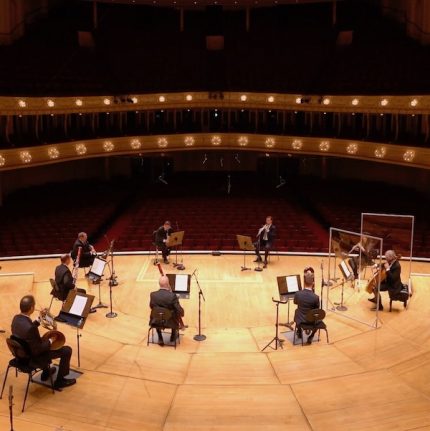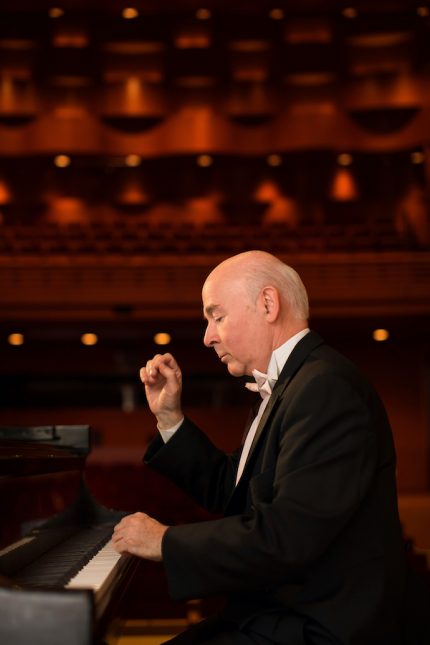Streaming CSO Sessions provide aural, visual balm to listeners in lockdown

Ten months into the Covid-19 pandemic, the Chicago Symphony Orchestra, in company with several other top-tier U.S. ensembles, is refusing to sing the lockdown blues.
October 1 brought the debut of CSO Sessions, a set of hour-long chamber music concerts performed by members of the orchestra and filmed onstage the previous month at Orchestra Hall, Symphony Center. Available on demand at the organization’s website (cso.org/csotv/cso-sessions),the series has thus far yielded nine “premium episodes”; a 10th segment, “Home for the Holidays”—baroque concertos and brass-ensemble arrangements of traditional Christmas favorites—goes online beginning today (December 17).
Fans of the brilliant, Chicago-based Mexican pianist Jorge Federico Osorio will be pleased to know that he recently filmed a full-length solo recital for the digital Symphony Center Presents On Demand series; that concert is available at the CSO website through January 27, 2021. order.cso.org
One may regret that the digital alternative to live concerts the CSO has chosen as its immediate response to the pandemic is not more musically venturesome—both the Boston Symphony Orchestra and San Francisco Symphony, to name just two such elite ensembles, are mounting bolder initiatives to keep faith with their public during the Covid era.
Still, one must concede that half a CSO loaf is far better than none—even an electronic, socially distanced loaf.
Online classical buffs may approach these video concerts with trepidation, wrongly associating them with amateurish Covid-era videos of instrumentalists making music via shaky laptop and glitch-filled Zoom hookups. Not the case here. One can take comfort in the high-tech professionalism and aural-visual excellence with which the CSO Sessions have been put together.
Still, it is initially disconcerting to be plunged into panoramic views of a nearly empty Armour Stage and a vacant auditorium of red-velvet seats. But one quickly adjusts, as multiple cameras hone in on the various chamber ensembles, their long shots, quick cuts and slow zooms nicely meshing with warm, clear, intimate audio. Crowned with its flying saucer-like acoustical shell, its semicircle bathed in a golden glow, the stage has seldom looked—or sounded—so handsome.
Of the four CSO Sessions segments this reviewer has screened thus far along with the Osorio recital, only once or twice did the rhythms of the music feel as if they were betrayed by the rhythms of the camera. The nervous camera cuts in the fast portions of Dvořák’s Wind Serenade (Episode 9) make you think you’re watching the musical equivalent of a ping-pong game. Mostly, however, the camerawork is unobtrusive, the audio excellent, and the glossy production values complement and enhance the music-making.
The highlight of the ninth segment—streaming through January 8—is CSO composer-in-residence Missy Mazzoli’s 2010 string quartet, Death Valley Junction. Inspired by the survival of a dilapidated opera house in the eponymous town on the California/Nevada border, the piece begins with an evocation of the harsh desert landscape—slow glissandos atop pulsing, post-minimalist rhythms—before breaking into a quirkily exuberant dance. An enjoyable romp, cleanly dispatched by a quartet consisting of concertmaster Robert Chen, associate concertmaster Stephanie Jeong, violist Catherine Brubaker and cellist Karen Basrak. Certainly, it fuels one’s anticipation of hearing the orchestral Mazzoli once the CSO is able to reconstitute itself, post-pandemic. Along with the Mazzoli and the Dvořák serenade, the concert includes Mozart’s Eine kleine Nachtmusik, showcasing the skills of 19 polished CSO strings.
Another string-ensemble favorite enlisting roughly the same number of players, Tchaikovsky’s Serenade for Strings, adds to the aural pleasures of Episode 8 (available through January 1), a mixed grille of works for various ensemble combinations. The celebratory burst of Coplandesque brass and percussion that is Joan Tower’s Fanfare for the Uncommon Woman No. 1 ushers in George Walker’s Lyric for Strings, the late American composer’s most widely performed piece; a 20-player string ensemble caught its elegiac mood with deep feeling. This music in turn stood in stark contrast to Darius Milhaud’s wind quintet The Chimney of King Rene, its jaunty charm well captured by an ensemble led by flutist Stefan Ragnar Hoskuldsson, oboist Michael Henoch, clarinetist John Bruce Yeh, bassoonist Keith Buncke, and hornist David Griffin.
Episode 7 (available through this Friday) is devoted to a complete performance of Stravinsky’s The Soldier’s Tale. The crisply alert reading under Erina Yashima’s direction strikes an eerily contemporaneous chord, as the conductor (a former Sir Georg Solti conducting apprentice with the CSO, now assistant conductor of the Philadelphia Orchestra) points out in her spoken introduction: the composer’s wry musical fable dates from the time of the Spanish flu epidemic and worldwide economic distress, Yashima noted. James Earl Jones II proves himself an engaged and engaging narrator, taking all three roles in the melodrama with clear diction and a refreshing absence of exaggeration; he’s abetted by a stylish ensemble of seven strings, winds and percussion.

As a rule, piano recitals are not visual experiences, but the nicely varied program Osorio performed for the cameras two months ago on the bare Orchestra Hall stage looks as terrific as it sounds. The gilded Beaux-Arts-style beauty of the auditorium is fully captured by the cameras and serves as an appropriate frame for the pianist’s perceptive, engrossing performances. Spanish pieces by Soler and Granados are as clearly and atmospherically turned as one could wish to hear, and three Debussy vignettes—including two Preludes (a dazzling Feux d’artifice and Cathedrale engloutie)—unfold within a seemingly limitless spectrum of soft dynamics. There is also a thoughtfully conceived and executed Brahms group, and Liszt’s Vallee d’Obermann—grand-manner pianism that packs genuine excitement without a trace of vulgarity. All in all, a recital piano and Osorio lovers will not want to miss.
It’s worth noting that Episode 2 of CSO Sessions has just been re-released as a free, encore presentation; the episode comprises Mozart’s Serenade No. 11 for Winds and Tchaikovsky’s Souvenir de Florence, with many CSO principals anchoring the wind and string ensembles. Streaming of more recent segments will continue into January, and new episodes no doubt will extend the series well into the new year. (Perhaps vocal chamber music could be added to the mix.) Premium episodes start at $15; discounts for purchases of three or more are available.
There is, of course, no substitute for hearing Chicago’s great orchestra playing with a full complement of musicians before a packed audience at Orchestra Hall. But until we are told it’s safe to return to that venerable cultural citadel for our normal fixes of live symphonic music, these digital CSO Sessions provide a welcome place-holder.